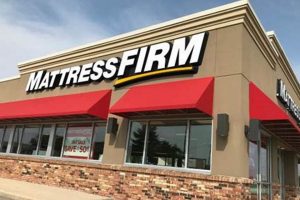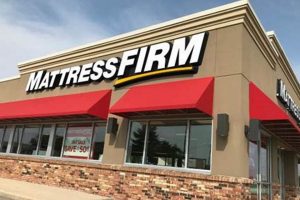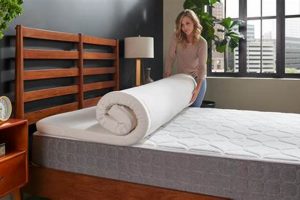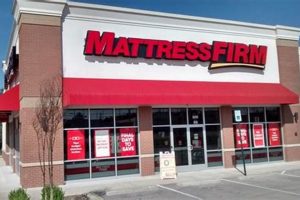A sleep surface offering customizable support levels allows individuals to modify the feel of the bed to meet their specific comfort preferences. For example, a user might select a plusher setting for pressure relief or a firmer setting for increased spinal alignment.
The significance of such a sleep system lies in its adaptability to changing needs and preferences. Benefits include potential improvements in sleep quality, reduced pressure points, and enhanced spinal support. Historically, options for customizing bed feel were limited, but advancements in materials and design have broadened the possibilities for individual comfort adjustment.
The following sections will delve into the underlying technologies, potential advantages, considerations for selection, and maintenance aspects of this type of sleep solution.
Tips for Selecting an Adjustable Firmness Mattress
Choosing a sleep surface offering customizable support requires careful consideration. The following tips are designed to guide informed decision-making.
Tip 1: Research Available Technologies: Investigate the mechanisms by which firmness is adjusted. Options may include air chambers, internal support layers that can be rearranged, or combinations thereof. Each technology presents unique characteristics in terms of responsiveness, durability, and maintenance requirements.
Tip 2: Define Personal Comfort Preferences: Prior to evaluating models, determine the desired firmness range. Consider typical sleep positions and any existing musculoskeletal conditions that may influence comfort needs. A too-soft surface may lack adequate support, while an excessively firm surface may exacerbate pressure points.
Tip 3: Assess Adjustment Range and Incrementality: Evaluate the degree of firmness variation available. A broader range allows for greater flexibility in accommodating individual preferences. Consider the granularity of adjustment; finer increments enable more precise tailoring of the sleep surface.
Tip 4: Scrutinize Materials and Construction: Examine the quality and durability of the materials used in construction. Higher-quality materials, such as dense foams or reinforced air chambers, contribute to longevity and consistent performance. Pay attention to warranties and return policies.
Tip 5: Consider Partner Compatibility: If sharing the bed, assess whether the model allows for independent firmness adjustments on each side. This feature can be particularly beneficial when partners have differing comfort preferences or body weights.
Tip 6: Evaluate Noise Levels: For models utilizing air chambers, assess the noise produced by the inflation/deflation mechanism. Excessive noise can disrupt sleep, particularly for light sleepers. Read reviews and, if possible, test the system in person.
Tip 7: Review Expert Opinions and Customer Feedback: Consult independent mattress reviews from reputable sources and carefully consider customer testimonials. Pay attention to comments regarding long-term durability, responsiveness, and customer service experiences.
Selecting a sleep surface with adaptable firmness requires a thorough understanding of individual needs and available product features. By carefully considering these tips, a suitable model can be identified.
The subsequent sections will explore the long-term ownership considerations and address common questions regarding these types of mattresses.
1. Support Customization
Support customization is a core function of the adaptable sleep surface, representing the primary differentiator from traditional mattresses. Its relevance stems from the inherent variability in individual comfort preferences and physiological needs related to sleep.
- Adjustable Zones
Adjustable zones within the mattress allow for independent modification of firmness levels in different areas of the sleep surface. For example, the lumbar region might require increased support for spinal alignment, while the shoulder area may benefit from a softer setting to alleviate pressure points. Such zoned support can be beneficial for individuals with specific musculoskeletal conditions or varying sleep positions.
- Firmness Range
The range of firmness offered by the system dictates the degree of customization possible. A wider range allows for finer adjustments and greater adaptability to changing needs. Insufficient range may limit the ability to achieve optimal comfort. This is particularly relevant as user’s physical conditions or preferences evolve over time.
- Underlying Mechanisms
The method by which firmness is adjusted is a critical aspect of support customization. Air chambers, adjustable foam layers, and integrated support systems each present unique advantages and disadvantages in terms of responsiveness, durability, and ease of use. Understanding these mechanisms is essential for selecting a mattress that aligns with individual preferences and long-term expectations.
- Partner Independence
For shared sleep surfaces, the ability to independently customize support on each side of the mattress is crucial. This feature accommodates differing body weights, sleep positions, and comfort preferences between partners, minimizing sleep disruption and maximizing individual comfort. Its absence may result in compromise and suboptimal sleep quality for one or both individuals.
These facets of support customization collectively define the adaptability and effectiveness of the adaptable sleep surface. The user’s ability to fine-tune these elements directly influences comfort, spinal alignment, and overall sleep quality. Therefore, a thorough assessment of these components is paramount in selecting a product that meets individual needs and preferences.
2. Pressure Relief
Pressure relief, a critical component of sleep comfort, is directly influenced by the adaptability of firmness in a mattress. A sleep surface that conforms to the body’s contours minimizes concentrated pressure on specific areas, such as shoulders, hips, and knees. Insufficient pressure relief can lead to discomfort, restlessness, and potential exacerbation of existing joint pain or circulatory issues. Conversely, excessive sinking into the mattress can compromise spinal alignment, negating any pressure-relieving benefits. For instance, an individual with arthritis might experience heightened pain on a surface that lacks adequate pressure redistribution.
Adjustable firmness allows users to optimize pressure relief according to their individual needs. By selecting a softer setting, the mattress conforms more readily, distributing weight over a larger surface area and reducing peak pressure points. This is particularly beneficial for side sleepers, who tend to expe
rience increased pressure on the hips and shoulders. Conversely, a firmer setting prevents excessive sinking, maintaining spinal alignment while still providing a degree of cushioning. This is crucial for back sleepers and individuals who require additional support. A real-world example is a person recovering from surgery; they might adjust the mattress to minimize pressure on sensitive areas while ensuring adequate spinal support for healing.
Understanding the relationship between adaptable firmness and pressure relief empowers consumers to make informed decisions. While marketing materials often emphasize the benefits of pressure relief, the actual effectiveness depends on the individual’s ability to customize the mattress to their specific needs. Challenges include accurately assessing personal pressure relief requirements and navigating the range of available firmness settings. The ability to effectively utilize adjustable firmness is key to optimizing sleep comfort and promoting overall well-being.
3. Spinal Alignment
Maintaining proper spinal alignment during sleep is crucial for musculoskeletal health and overall well-being. The adaptability of a sleep surface to individual body contours and sleep positions plays a significant role in achieving this alignment. An adjustable firmness mattress offers the potential to customize support levels, thereby influencing spinal positioning throughout the night.
- Neutral Spine Position
The goal is to maintain the spine’s natural curves, minimizing stress on vertebral discs and surrounding tissues. An adaptable sleep surface facilitates this by providing appropriate support under the shoulders, hips, and lumbar region, preventing excessive sagging or arching. For example, a side sleeper requires sufficient shoulder and hip compression to maintain a straight spinal column, while a back sleeper benefits from lumbar support to preserve the natural inward curve.
- Firmness and Support Relationship
Firmness, or the surface feel, is distinct from support, which is the mattress’s ability to prevent excessive compression. An adjustable firmness mattress aims to optimize both. Too soft a surface may compromise support, leading to spinal misalignment. Conversely, an overly firm surface may not conform to body contours, creating pressure points and hindering natural alignment. Proper adjustment balances these competing needs.
- Accommodation of Sleep Positions
Individuals adopt various sleep positions throughout the night. An adaptable mattress allows for adjustments to accommodate these changes. A back sleeper may require a firmer setting than a side sleeper, and the ability to modify firmness levels allows for tailored support regardless of the adopted position. Static mattresses often necessitate compromise, potentially leading to discomfort and suboptimal spinal alignment in certain positions.
- Long-Term Musculoskeletal Health
Consistently maintaining proper spinal alignment during sleep can contribute to long-term musculoskeletal health. Chronic misalignment can exacerbate existing conditions or contribute to the development of back pain, neck pain, and other related issues. By providing a customizable support system, an adjustable firmness mattress offers the potential to mitigate these risks and promote healthier sleep posture.
The ability to fine-tune support levels is a key advantage of adjustable firmness mattresses in promoting proper spinal alignment. However, it requires a conscious effort from the user to understand their individual needs and to make appropriate adjustments. The potential benefits for musculoskeletal health make it a compelling option for those seeking to optimize their sleep environment.
4. Partner Compatibility
The concept of partner compatibility, within the context of sleep surfaces, gains significant relevance when considering adjustable firmness mattresses. Dissimilar preferences for sleep surface feel, stemming from variations in body weight, sleep position, or medical conditions, often lead to sleep disruption for one or both partners. An adaptable firmness mattress, particularly those with independently adjustable zones, directly addresses this issue. Independent adjustability permits each individual to customize their side of the bed to their preferred firmness level, mitigating the compromises inherent in traditional, uniformly firm mattresses. For instance, one partner may prefer a firmer surface for back support, while the other favors a plusher feel for pressure relief. Without independent adjustability, one partner’s comfort is necessarily prioritized over the other’s, potentially leading to restless nights and long-term sleep deprivation.
The practical significance of this lies in improved sleep quality for both individuals. Enhanced sleep leads to improved mood, increased energy levels, and better overall health. Furthermore, reduced sleep-related conflict contributes positively to the relationship. Consider the scenario of a couple where one partner suffers from chronic back pain requiring a firm sleep surface, while the other prefers a softer mattress. An adaptable firmness mattress with independent zones provides a practical solution, allowing both partners to achieve optimal comfort and support without compromising each other’s sleep. The economic implications extend beyond the initial purchase price; improved sleep can translate to reduced healthcare costs associated with sleep deprivation and related health issues.
In summary, partner compatibility is a crucial element in the overall assessment of adaptable sleep surfaces. The ability to independently customize firmness levels offers a tangible solution to the common problem of differing comfort preferences. While the initial investment may be higher than a traditional mattress, the long-term benefits encompassing improved sleep quality, enhanced health, and strengthened relationships often justify the expenditure. The challenge lies in thoroughly researching available options and understanding the specific needs of each partner to ensure the selected mattress offers truly independent and effective adjustability.
5. Durability Concerns
The inherent complexity of adaptable sleep surfaces introduces durability considerations that are less prevalent in traditional mattresses. Moving parts, electronic components, and segmented construction can create vulnerabilities that impact long-term performance and lifespan. Careful assessment of these factors is crucial prior to purchase.
- Air Chamber Integrity
For models employing air chambers, the durability of these chambers is paramount. Repeated inflation and deflation cycles, coupled with the weight of the occupants, can stress the material. Leaks, while often repairable, represent a significant inconvenience and can compromise the support and comfort of the mattress. High-quality materials and robust construction techniques are essential for minimizing the risk of air chamber failure.
- Pump and Motor Reliability
Electronically adjustable models rely on pumps and motors to inflate and deflate the air ch
ambers. The longevity and reliability of these components directly influence the lifespan of the mattress. Frequent use, power fluctuations, and manufacturing defects can lead to premature failure. Choosing models with reputable components and comprehensive warranties is advisable. - Foam Degradation
The foam layers that provide cushioning and support in conjunction with the adjustable components are subject to compression and degradation over time. Lower-density foams may exhibit premature sagging or loss of resilience, impacting the overall comfort and support characteristics of the mattress. Higher-density foams and innovative materials, while potentially more expensive, offer improved durability and resistance to degradation.
- Seam and Stitching Strength
The seams and stitching that hold the various components of the mattress together are critical points of potential failure. Stresses from movement and weight can strain these areas, leading to tears or separation. Reinforced stitching, durable fabrics, and careful construction techniques contribute to the overall longevity of the mattress.
These durability considerations highlight the importance of thoroughly researching the construction and components of adaptable sleep surfaces. While the customizable comfort offered by these mattresses is appealing, potential buyers must carefully weigh the benefits against the risks associated with increased complexity and potential points of failure. Selecting models from reputable manufacturers with comprehensive warranties is a prudent approach to mitigating these concerns.
6. Technology Integration
Technology integration is a defining characteristic of modern adaptable sleep surfaces, distinguishing them from their traditional counterparts. The incorporation of electronic and mechanical systems facilitates customized comfort and support, introducing both advantages and complexities.
- Embedded Sensors and Feedback Systems
Some models incorporate embedded sensors to monitor pressure distribution and body position in real-time. This data is then utilized to automatically adjust firmness levels, optimizing support based on individual needs. This closed-loop feedback system aims to provide dynamic comfort and prevent pressure points. Example: A sensor might detect increased pressure on the shoulder during side sleeping and automatically soften the corresponding zone. Implication: Enhanced comfort but increased complexity and potential points of failure.
- Remote Control and Mobile App Integration
Digital interfaces provide a user-friendly means of controlling firmness settings. Remote controls and mobile applications offer precise adjustments and the ability to save personalized profiles. These interfaces can also integrate with other smart home devices. Example: A user could set the mattress to a firmer setting in the morning and a softer setting at night via a scheduled command. Implication: Greater convenience and customization but reliance on electronic devices and potential security vulnerabilities.
- Active Cooling and Heating Systems
Temperature regulation technology can be integrated into the mattress design. These systems actively circulate air or utilize phase-change materials to maintain a comfortable sleeping temperature. Example: Integrated fans could draw heat away from the body, preventing overheating during warm nights. Implication: Improved sleep quality by addressing thermal discomfort, but added energy consumption and potential noise generation.
- Diagnostic and Maintenance Features
Advanced models may incorporate diagnostic capabilities that monitor system performance and alert users to potential issues. This proactive approach aims to prevent failures and extend the lifespan of the mattress. Example: The system might detect a slow leak in an air chamber and notify the user to take corrective action. Implication: Reduced downtime and improved reliability, but increased manufacturing complexity and data collection concerns.
These technological advancements enhance the functionality and appeal of adaptable sleep surfaces. However, consumers should carefully consider the trade-offs between increased features and potential drawbacks related to reliability, maintenance, and data privacy. A thorough understanding of the implemented technologies is essential for making an informed purchase decision.
7. Long-Term Cost
Assessing the long-term cost associated with a sleep surface necessitates a comprehensive evaluation that extends beyond the initial purchase price. Adaptable firmness mattresses present unique cost considerations compared to conventional models, stemming from their inherent complexity and technological integration.
- Component Replacement Expenses
Adaptable firmness mattresses often incorporate electronic components, such as air pumps and control systems, which are subject to wear and potential failure. The replacement cost of these components can be substantial, particularly if the mattress is no longer under warranty. For example, an air pump malfunction may necessitate professional repair or replacement of the entire pump assembly, incurring significant expenses not typically associated with traditional mattresses. This factor contributes to the overall long-term cost of ownership.
- Energy Consumption Costs
Electronically adjustable mattresses consume energy to operate air pumps, heating elements, and other integrated features. While individual energy consumption may be minimal, the cumulative cost over the lifespan of the mattress can be non-negligible. For instance, continuous operation of a heating system throughout the winter months will increase electricity bills. The total energy consumption cost should be factored into the long-term cost assessment.
- Maintenance and Repair Expenses
The complex design of adaptable firmness mattresses can increase the likelihood of requiring professional maintenance or repairs. Air leaks, control system malfunctions, and component failures may necessitate specialized service calls, resulting in additional expenses. Regular maintenance, such as cleaning air chambers and inspecting components, can mitigate some risks, but unforeseen repairs can significantly impact the overall cost of ownership.
- Depreciation and Replacement Cycle
Adaptable firmness mattresses, due to their intricate construction and technological components, may experience a faster rate of depreciation compared to traditional mattresses. Technological obsolescence and component wear can necessitate earlier replacement. The shortened replacement cycle contributes to the overall long-term cost, as frequent replacements can exceed the cumulative cost of a more durable, albeit less customizable, alternative.
These factors collectively influence the long-term cost associated with adjustable firmness mattresses. While the initial investment may be attractive due to the customizable comfort offered, potential buyers should carefully consider the ongoing expenses related to component replacement, energy consumption, maintenance, and depreciation. A comprehensive cost analysis, encompassing both initial and long-term expenditures, is essential for making an infor
med purchasing decision.
Frequently Asked Questions
The following addresses common inquiries and concerns regarding adjustable firmness mattresses, providing objective information for informed decision-making.
Question 1: What is the typical lifespan of an adjustable firmness mattress?
Lifespan varies depending on construction quality, materials, and usage patterns. Generally, expect a lifespan of 7-10 years. Models with robust components and diligent maintenance may exceed this range. Factors such as air chamber integrity, pump reliability, and foam degradation influence longevity.
Question 2: Are adjustable firmness mattresses suitable for individuals with back pain?
The suitability for back pain sufferers depends on the individual’s specific condition and the mattress’s adjustability range. The capability to customize support can potentially alleviate pressure points and promote spinal alignment. Consultation with a healthcare professional is recommended prior to making a purchase.
Question 3: What types of adjustable firmness technologies are available?
Common technologies include air chambers, layered foam systems, and internal support structures that can be rearranged. Air chamber systems utilize inflatable bladders to regulate firmness, while layered foam systems incorporate removable or adjustable foam inserts. Each technology offers unique advantages and disadvantages in terms of adjustability, responsiveness, and durability.
Question 4: What is the average price range for an adjustable firmness mattress?
Price ranges vary significantly based on brand, technology, materials, and features. Entry-level models may start around $1000, while high-end models with advanced features can exceed $5000. Consider long-term costs, including potential maintenance and repair expenses, when evaluating affordability.
Question 5: How much maintenance is required for an adjustable firmness mattress?
Maintenance requirements vary depending on the type of mattress. Air chamber systems may require occasional inflation adjustments and inspection for leaks. Foam mattresses may benefit from regular rotation to prevent uneven wear. Consult the manufacturer’s recommendations for specific maintenance guidelines.
Question 6: Do adjustable firmness mattresses emit any noise during operation?
Models utilizing air pumps may generate some noise during inflation and deflation. Noise levels vary depending on the pump design and construction. Consider the noise level, particularly if sensitive to sound, when selecting a model. Reviewing customer feedback regarding noise is recommended.
Adjustable firmness mattresses offer customized sleep solutions, but careful consideration of factors such as lifespan, suitability for back pain, technology, price, maintenance, and noise is essential.
The subsequent section will delve into optimal user practices to get the most out of such a sleep system.
adjustable firmness mattress
This exploration has analyzed the core elements of an adjustable firmness mattress, including its mechanisms, benefits, potential drawbacks, and long-term ownership considerations. Key aspects such as support customization, pressure relief, spinal alignment, partner compatibility, durability, technology integration, and long-term cost were examined to provide a comprehensive understanding of this sleep solution.
The integration of adaptable technology into sleep surfaces represents a significant advancement in personalized comfort. While the customizable nature of the adjustable firmness mattress offers potential advantages, informed decision-making necessitates a thorough evaluation of individual needs and a careful assessment of product features, construction quality, and potential maintenance requirements. Such due diligence is essential to ensuring long-term satisfaction and maximizing the investment in this sophisticated sleep system.







